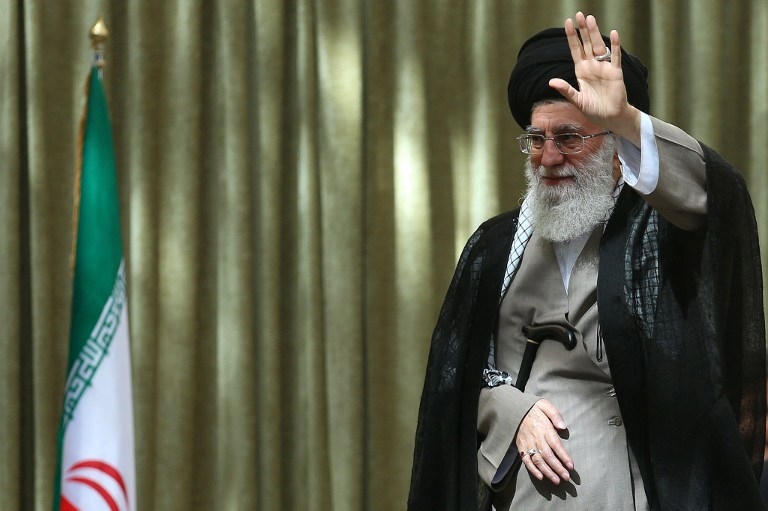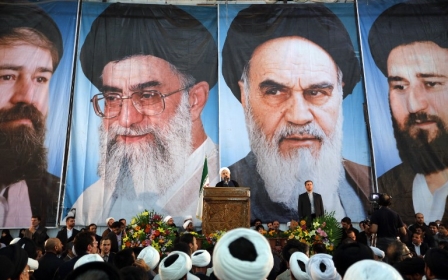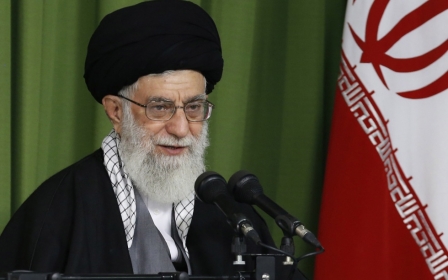Iran’s leader strikes a note of complexity

Speaking this Wednesday on the twenty fifth anniversary of the demise of the founder of the Islamic Republic of Iran, the late Ayatollah Ruhollah Khomeini, Iran’s supreme leader Ayatollah Khamenei delivered one of his strongest motivational speeches of recent years.
Addressing a large gathering at Khomeini’s mausoleum in south Tehran, Khamenei used the occasion to transmit a set of strategic messages to a wide range of domestic, regional and international audiences.
The anniversary of the late Ayatollah Khomeini’s death in early June is always a special occasion in the Islamic Republic, inasmuch as it allows the country’s leaders and officials to pledge loyalty to Khomeini’s heritage and the foundational values of the Iranian revolution of 1979.
This year signifies an important watershed, at least from a symbolic point of view, as it marks a quarter century of Khomeini’s demise and, by extension, the rule of his successor Ayatollah Khamenei. It is against this symbolic backdrop that Khamenei’s speech assumes an elevated level of importance.
Whilst Khamenei maintained his defiant posture in the face of Western pressure, there are elements in his speech that point to a potential shift in policy in the years ahead. With negotiations on Iran’s disputed nuclear programme set to reach a critical stage later this year against the backdrop of Iran’s growing regional influence and confidence, Western leaders should take note of Ayatollah Khamenei’s complex positioning.
Remaining defiant
Year after year since 1990, Ayatollah Khamenei has used the anniversary of Khomeini’s demise to motivate the Islamic Republic’s grassroots base and to warn the country’s officials against deviating from the foundational values of the Iranian revolution.
Khamenei also uses the occasion to strike a defiant posture against the West with a view to affirming the conceptual and ideological basis of post-revolutionary Iranian foreign policy.
To achieve this mix of motivational, ideological and rhetorical effect, this year Khamenei stressed the phenomenon of “Islamic Awakening”, and the Islamic Republic’s continuing supremacy in the sphere of political Islam.
Originally framed to explain the half revolutions and street protests which rocked some parts of the Arab world in late 2010 and 2011, referred to by the Western media as the “Arab Spring”, the concept of an “Islamic Awakening” has now been fully adopted by foreign policy and intelligence circles in Tehran as a cardinal feature of the country’s strategic outlook.
From the outset, the rhetoric surrounding the “Islamic Awakening” faced serious conceptual problems, not least because Iranian leaders and officials consciously and cynically exempted Syria from this putative phenomenon.
Furthermore, if “Islamic Awakening” in part referred to the empowerment of Islamic groups associated with the Muslim Brotherhood, this was also deeply problematic in so far as the latter does not identify with the Iranian spin on political Islam.
More than three years on and with the Muslim Brotherhood and its allies in disarray resulting from former Egyptian president Mohammad Morsi’s overthrow last July, the concept of an “Islamic Awakening” has practically lost all of its descriptive power.
Instead what Khamenei refers to as “Islamic Awakening” is now merely a cover for Iran’s renewed drive to consolidate its position as the region’s dominant power, especially in its conflict with Saudi Arabia over influence in Bahrain, Syria and Lebanon.
By implicitly linking conservative Arab regimes to the West, Khamenei claimed that “Global Arrogance” (i.e. the Western powers) makes a “strategic” mistake by believing it can wipe out the phenomenon of “Islamic Awakening”, failing to understand that the causes and consciousness that gave rise to the phenomenon in the first place cannot be destroyed and that sooner or later this movement will “spread” its presence and influence.
This is a direct challenge to Saudi Arabia and its Western supporters inasmuch as it signifies Iran’s continuing quest to shape a Middle East free from Western domination and influence. It also points to continuing tension and possibly conflict if Iran believes it can conclusively prevail over its regional and global adversaries in the Middle Eastern arena.
Nuanced messages
Despite Khamenei’s expectedly tough ideological position, there was one important departure from the past. Directly addressing the nuances of American foreign policy, Khamenei claimed that the United States divides the world into three spheres, namely countries that are totally under American control, those that the US tolerates and engages and, lastly, countries that are in opposition to America’s global role.
Interestingly, Khamenei places “European” countries in the second category countries that are merely “tolerated” by the United States in view of common interests, but that the Americans would not “hesitate” to “stab in the heart” should the need arise. Khamenei even referred to America’s wide ranging electronic surveillance operations aimed at European citizens and leaders, to back up his claims.
This is a clear attempt to make a fundamental distinction between the United States and the European powers, and it is a significant departure from the past, at least in ideological terms in so far as, to date, the Islamic Republic has tended to view the “West” as a cohesive and indivisible entity. It augurs well for Iran’s relations with the European Union, especially if key European powers, namely Germany and France, take on a bigger role in the negotiations aimed at resolving the nuclear dispute.
In a related point, Khamenei made a thinly disguised reference to the crisis in Ukraine (without naming the country), as an example of where the Unites States funds a minority to take to the streets to destabilise a government that it does not like. In a remarkable gesture, and even though he was clearly explaining American actions in negative terms, Khamenei claimed that “we don’t make judgements on this issue”. In other words, Iran is neutral on the Ukraine crisis.
By any standard, this is a remarkable position and the message is aimed both at the international community and Iranian hardliners who aspire to align the country closer to Russia in order to disrupt any potential opening to the West.
As far as the international community is concerned, this should be interpreted as a potential shift in Iran’s outlook and, by extension, policy on engagement with Western powers. However, by maintaining his tough rhetoric on the United States, Iran’s leader makes clear that any shift will be painfully slow and conditional on adequate reciprocal actions.
- Mahan Abedin is an analyst of Iranian politics. He is the director of the research group Dysart Consulting.
The views expressed in this article belong to the author and do not necessarily reflect the editorial policy of Middle East Eye.
Photo credit: Ayatollah Ali Khamenei waves after delivering a speech on the 25th anniversary of the death of the founder of the Islamic Republic Ayatollah Ruhollah Khomeini (AFP)
Stay informed with MEE's newsletters
Sign up to get the latest alerts, insights and analysis, starting with Turkey Unpacked
Middle East Eye delivers independent and unrivalled coverage and analysis of the Middle East, North Africa and beyond. To learn more about republishing this content and the associated fees, please fill out this form. More about MEE can be found here.





